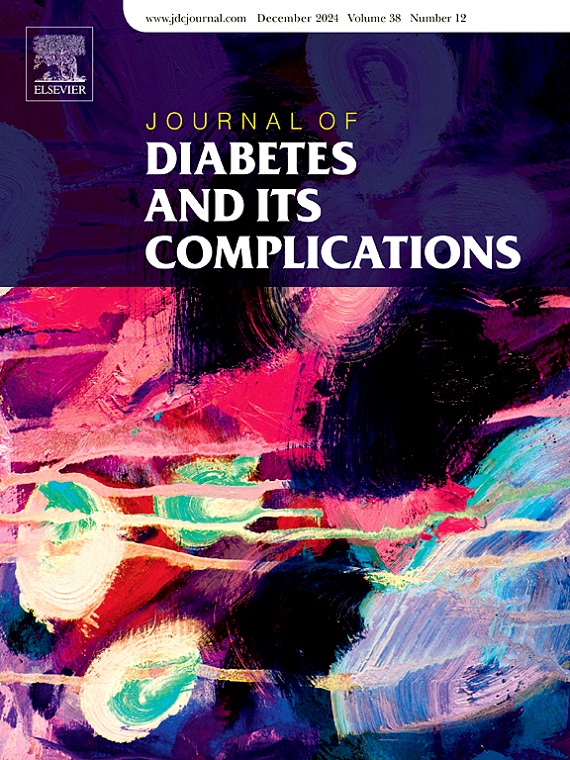Relationship between relative fat mass and coronary artery calcification in patients with type 2 diabetes
IF 3.1
3区 医学
Q3 ENDOCRINOLOGY & METABOLISM
引用次数: 0
Abstract
Aims
Relative fat mass (RFM) is a promising tool for identifying individuals with obesity-related health risks. Given the unclear correlation, we aimed to investigate the association between RFM and coronary artery calcification (CAC) in individuals with T2DM.
Methods
We included hospitalized individuals aged 20–80 years with T2DM (n = 278) in this single-center cross-sectional study. We explored the correlation between RFM and the CAC score (CACS), mechanisms underlying the association between RFM and CAC, and prediction models of coronary artery stenosis (CAS).
Results
Compared to the non-CAC group, the CAC group had a higher RFM. The CACS and RFM were positively correlated. The RFM independently increased the risk of CAC in individuals with T2DM. Using RFM to predict CAC resulted in an area under the curve of 0.598 (95 % CI [0.531–0.664], p < 0.01); RFM was not inferior to visceral fat area for predicting CAC. Insulin resistance, systolic blood pressure, and estimated glomerular filtration rate mediated the association between RFM and CAS with proportions of 9.38 %, 18.82 %, and 11.36 %, respectively.
Conclusions
RFM was associated with CAC in individuals with T2DM. Given its potential role in predicting cardiovascular complications, incorporating RFM into clinical practice may facilitate the prevention and management of cardiovascular complications in T2DM.
2型糖尿病患者相对脂肪量与冠状动脉钙化的关系
目的相对脂肪量(RFM)是一种很有前景的识别肥胖相关健康风险个体的工具。鉴于不明确的相关性,我们旨在研究T2DM患者RFM与冠状动脉钙化(CAC)之间的关系。方法在这项单中心横断面研究中,我们纳入了20-80岁住院的T2DM患者(n = 278)。我们探讨了RFM与CAC评分(CACS)之间的相关性,RFM与CAC之间关联的机制,以及冠状动脉狭窄(CAS)的预测模型。结果与非CAC组相比,CAC组的RFM更高。CACS与RFM呈正相关。RFM单独增加了2型糖尿病患者患CAC的风险。使用RFM预测CAC的曲线下面积为0.598 (95% CI [0.531-0.664], p <;0.01);RFM在预测CAC方面不逊于内脏脂肪面积。胰岛素抵抗、收缩压和估计的肾小球滤过率介导了RFM和CAS之间的关联,其比例分别为9.38%、18.82%和11.36%。结论srfm与T2DM患者的CAC相关。考虑到RFM在预测心血管并发症方面的潜在作用,将RFM纳入临床实践可能有助于预防和管理T2DM心血管并发症。
本文章由计算机程序翻译,如有差异,请以英文原文为准。
求助全文
约1分钟内获得全文
求助全文
来源期刊

Journal of diabetes and its complications
医学-内分泌学与代谢
CiteScore
5.90
自引率
3.30%
发文量
153
审稿时长
16 days
期刊介绍:
Journal of Diabetes and Its Complications (JDC) is a journal for health care practitioners and researchers, that publishes original research about the pathogenesis, diagnosis and management of diabetes mellitus and its complications. JDC also publishes articles on physiological and molecular aspects of glucose homeostasis.
The primary purpose of JDC is to act as a source of information usable by diabetes practitioners and researchers to increase their knowledge about mechanisms of diabetes and complications development, and promote better management of people with diabetes who are at risk for those complications.
Manuscripts submitted to JDC can report any aspect of basic, translational or clinical research as well as epidemiology. Topics can range broadly from early prediabetes to late-stage complicated diabetes. Topics relevant to basic/translational reports include pancreatic islet dysfunction and insulin resistance, altered adipose tissue function in diabetes, altered neuronal control of glucose homeostasis and mechanisms of drug action. Topics relevant to diabetic complications include diabetic retinopathy, neuropathy and nephropathy; peripheral vascular disease and coronary heart disease; gastrointestinal disorders, renal failure and impotence; and hypertension and hyperlipidemia.
 求助内容:
求助内容: 应助结果提醒方式:
应助结果提醒方式:


